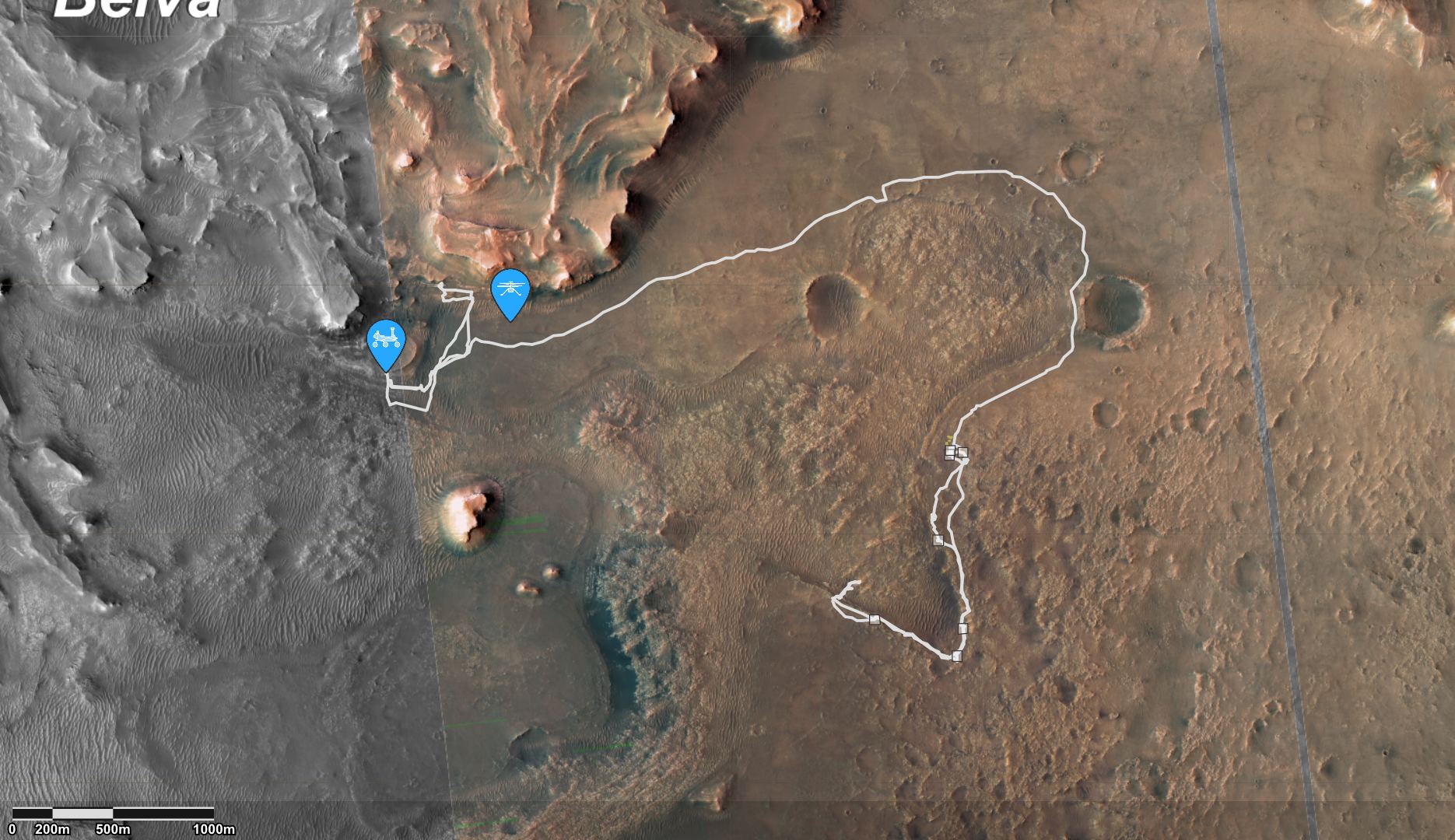In January 2004, NASA rovers Spirit and Opportunity (aka “Oppy”) landed in two completely different locations on Mars. Their missions were only designed to last 90 sols (approximately 90 Earth days), but they exceeded these parameters, and then some. While Spirit lasted until 2010, Opportunity lasted another astonishing eight years, when it sent its last transmission to Earth in June 2018. During its more than 14-year tenure on the Red Planet, not only did Opportunity gain celebrity status as being the longest serving planetary robotic explorer in history, but it helped reshape our understanding of Mars’ present and past. Now with the help of Amazon Studios and available on Amazon Video, we can re-live the adventure of this incredible rover with Good Night Oppy.
Continue reading ““Good Night Oppy” Beautifully Illustrates the Unbreakable Bond Between Humans and our Robotic Explorers”When Should Robots Take Risks Exploring Other Worlds?
On May 1st, 2009, after five years on the Martian surface, the Spirit rover got stuck in a patch of soft sand (where it would remain for the rest of its mission). On February 13th, 2019, NASA officials declared that Spirit’s sister – the Opportunity rover – had concluded its mission after a planetary dust storm forced it into hibernation mode about seven months prior. And in March 2017, the Curiosity rover’s wheels showed signs of their first break, thanks to years of traveling over rough terrain. Such are the risks of sending rover missions to other planets in search of discoveries that can lead to scientific breakthroughs.
But what constitutes an acceptable risk for a robotic mission, and when are mission controllers justified in taking them? As it turns out, a pair of researchers from the Robotics Institute‘s School of Computer Science at Carnegie Mellon University (CMU) in Pittsburgh have developed a new approach for weighing the risks against the scientific value of sending planetary rovers into dangerous situations. The researchers are now working with NASA to implement their approach for future robotic missions to the Moon, Mars, and other potentially-hazardous environments in the Solar System.
Continue reading “When Should Robots Take Risks Exploring Other Worlds?”NASA Senior Engineer Kobie Boykins talks About Exploring Mars. And I was There to See it!

As part of National Geographic Live, Chief Engineer Kobie Boykins of NASA’s Jet Propulsion Laboratory (JPL) has been touring the world of late. As part of the program’s goal of having featured speakers share their behind-the-scenes stories, Boykins has been showcasing the accomplishments of NASA’s Mars robotic exploration programs – of which he played a major role.
This week, his tour brought him to my hometown, where he delivered a presentation to a packed house at the Royal Theatre here in of Victoria, BC. Titled “Exploring Mars”, Boykins shared personal stories of what it was like to be an integral part of the team that created the Sojourner, Spirit, Opportunity, Curiosity and Mars 2020 rovers. I had the honor of attending the event, and being able to do a little Q&A with him after the show.
Continue reading “NASA Senior Engineer Kobie Boykins talks About Exploring Mars. And I was There to See it!”A Powerful Dust Storm Has Darkened the Skies Over Opportunity on Mars

NASA’s Opportunity mission can rightly be called the rover that just won’t quit. Originally, this robotic rover was only meant to operate on Mars for 90 Martian days (or sols), which works out to a little over 90 Earth days. However, since it made its landing on January 25th, 2004, it has remained in operation for 14 years, 4 months, and 18 days – exceeding its operating plan by a factor of 50!
However, a few weeks ago, NASA received disturbing news that potentially posed a threat to the “little rover that could”. A Martian storm, which has since grown to occupy an area larger than North America – 18 million km² (7 million mi²) – was blowing in over rover’s position in the Perseverance Valley. Luckily, NASA has since made contact with the rover, which is encouraging sign.
NASA’s Mars Reconnaissance Orbiter first detected the storm on Friday, June 1st, and immediately notified the Opportunity team to begin preparing contingency plans. The storm quickly grew over the next few days and resulted in dust clouds that raised the atmosphere’s opacity, which blocked out most of the sunlight from reaching the surface. This is bad news for the rover since it relies on solar panels for power and to recharge its batteries.
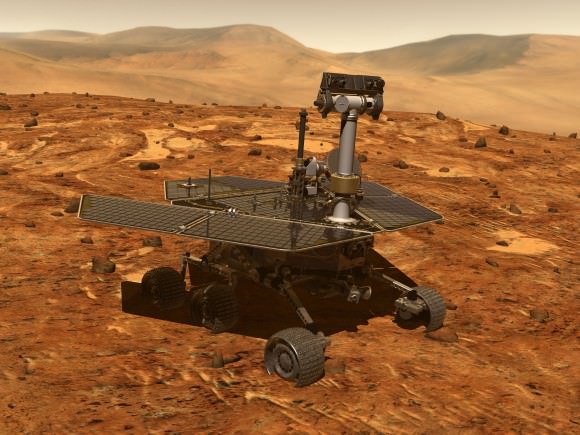
By Wednesday, June 6th, Opportunity’s power levels had dropped significantly and the rover was required to shift to minimal operations. But beyond merely limiting the rover’s operations, a prolonged dust storm also means that the rover might not be able to keep its energy-intensive survival heaters running – which protect its batteries from the extreme cold of Mars’ atmosphere.
The Martian cold is believed to be what resulted in the loss of the Spirit rover in 2010, Opportunity’s counterpart in the Mars Exploration Rover mission. Much like Opportunity, Spirit‘s mission as only meant to last for 90 days, but the rover managed to remain in operation for 2269 days (2208 sols) from start to finish. It’s also important to note that Opportunity has dealt with long-term storms before and emerged unscathed.
Back in 2007, a much larger storm covered the planet, which led to two weeks of minimal operations and no communications. However, the current storm has intensified as of Sunday morning (June 10th), creating a perpetual state of night over the rover’s location in Perseverance Valley and leading to a level of atmospheric opacity that is much worse than the 2007 storm.
Whereas the previous storm had an opacity level (tau) of about 5.5, this new storm has an estimated tau of 10.8. Luckily, NASA engineers received a transmission from the rover on Sunday, which was a positive indication since it proved that the rover still has enough battery charge to communicate with controllers at NASA’s Jet Propulsion Laboratory. This latest transmission also showed that the rover’s temperature had reached about -29 °C (-20 °F).
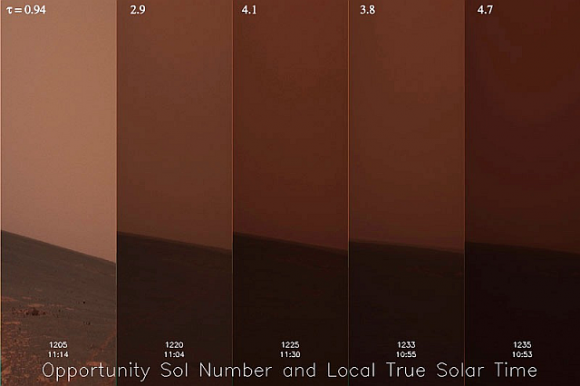
Full dust storms like this and the one that took place in 2007 are rare, but not surprising. They occur during summer in the southern hemisphere, when sunlight warms dust particles and lifts them higher into the atmosphere, creating more wind. That wind kicks up yet more dust, creating a feedback loop that NASA scientists are still trying to understand. While they can begin suddenly, they tend to last on the order of weeks or even months.
A saving grace about these storms is that they limit the extreme temperature swings, and the dust they kick up can also absorb solar radiation, thus raising ambient temperatures around Opportunity. In the coming weeks, engineers at the JPL will continue to monitor the rover’s power levels and ensure that it maintains the proper balance to keep its batteries in working order.
In the meantime, Opportunity’s science operations remain suspended and the Opportunity team has requested additional communications coverage from NASA’s Deep Space Network – the global system of antennas that communicates with all of the agency’s deep space missions. And if there’s one thing Opportunity has proven, it is that it’s capable of enduring!
Fingers crossed the storm subsides as soon as possible and the little rover that could once again emerges unscathed. At this rate, it could have many more years of life left in it!
Further News: NASA
Outstanding Opportunity Rover Making ‘Amazing New Discoveries’ 13 Years After Mars Touchdown – Scientist Tells UT
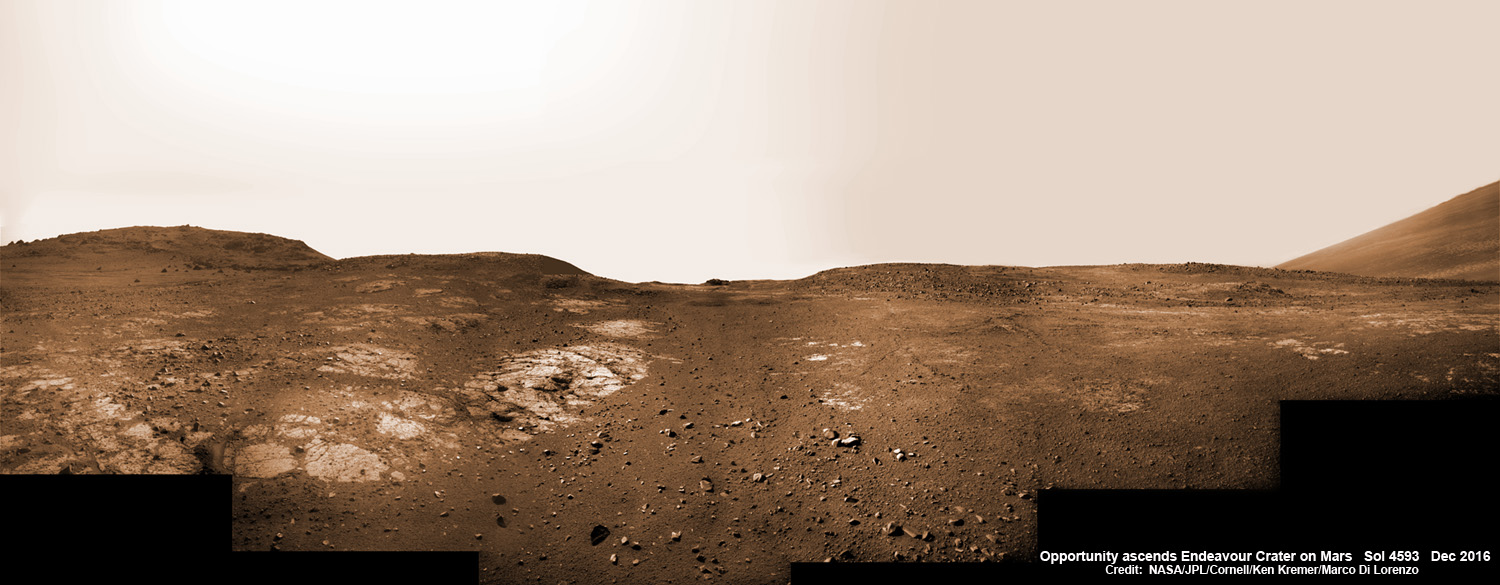

On Christmas Day 2016, NASA’s Opportunity rover scans around vast Endeavour crater as she ascends steep rocky slopes on the way to reach a water carved gully along the eroded craters western rim. This navcam camera photo mosaic was assembled from raw images taken on Sol 4593 (25 Dec. 2016) and colorized. Credit: NASA/JPL/Cornell/Ken Kremer/kenkremer.com/Marco Di Lorenzo
NASA’s truly outstanding Opportunity rover continues “making new discoveries about ancient Mars” as she commemorates 13 Years since bouncing to a touchdown on Mars, in a feat that is “truly amazing” – the deputy chief scientist Ray Arvidson told Universe Today exclusively.
Resilient Opportunity celebrated her 13th birthday on Sol 4623 on January 24, 2017 PST while driving south along the eroded rim of humongous Endeavour crater – and having netted an unfathomable record for longevity and ground breaking scientific discoveries about the watery environment of the ancient Red Planet.
“Reaching the 13th year anniversary with a functioning rover making new discoveries about ancient Mars on a continuing basis is truly amazing,” Ray Arvidson, Opportunity Deputy Principal Investigator of Washington University in St. Louis, told Universe Today.
Put another way Opportunity is 13 YEARS into her 3 MONTH mission! And still going strong!
During the past year the world famous rover discovered “more extensive aqueous alteration within fractures and more mild alteration within the bedrock outcrops” at Endeavour crater, Arvidson elaborated.
And now she is headed to her next target – an ancient water carved gully!
The gully is situated about 0. 6 mile (1.6 km) south of the robots current location.
But to get there she first has to heroically ascend steep rocky slopes inclined over 20 degrees along the eroded craters western rim – and it’s no easy task! Slipping and sliding along the way and all alone on difficult alien terrain.
Furthermore she is 51 times beyond her “warrantied” life expectancy of merely 90 Sols promised at the time of landing so long ago – roving the surface of the 4th rock from the Sun during her latest extended mission; EM #10.
How was this incredible accomplishment achieved?
“Simply a well-made and thoroughly tested American vehicle,” Arvidson responded.
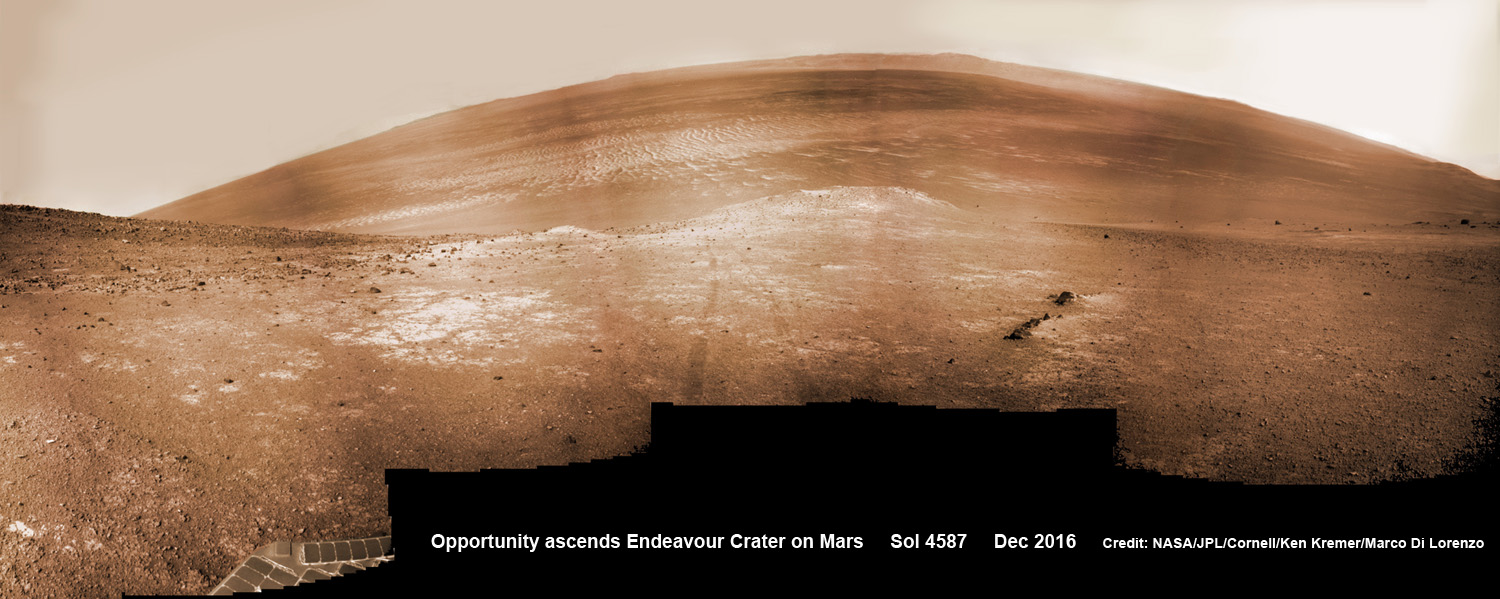
The six wheeled rover landed on Mars on January 24, 2004 PST on the alien Martian plains at Meridiani Planum -as the second half of a stupendous sister act.
Her twin sister Spirit, had successfully touched down 3 weeks earlier on January 3, 2004 inside 100-mile-wide Gusev crater and survived more than six years.
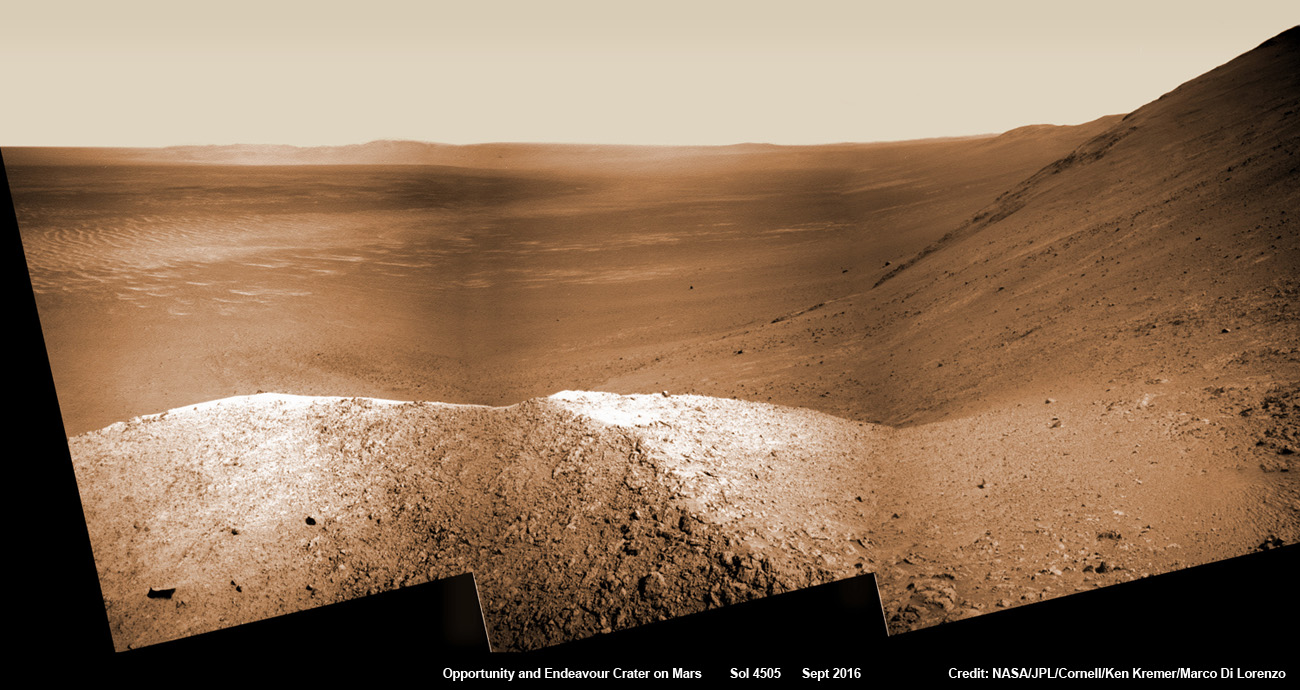
Opportunity concluded 2016 and starts 2017 marching relentlessly towards an ancient water carved gully along the eroded rim of vast Endeavour crater – the next science target on her heroic journey traversing across never before seen Red Planet terrains.
Huge Endeavour crater spans some 22 kilometers (14 miles) in diameter.
Throughout 2016 Opportunity was investigating the ancient, weathered slopes around the Marathon Valley location in Endeavour crater. The area became a top priority science destination after the slopes were found to hold a motherlode of ‘smectite’ clay minerals based on data from the CRISM spectrometer circling overhead aboard a NASA Mars orbiter.
The smectites were discovered via extensive, specially targeted Mars orbital measurements gathered by the CRISM (Compact Reconnaissance Imaging Spectrometer for Mars) spectrometer on NASA’s Mars Reconnaissance Orbiter (MRO) – accomplished earlier at the direction of Arvidson.
Opportunity was descending down Marathon Valley the past year to investigate the clay minerals formed in water. They are key to helping determine the habitability of the Red Planet when it was warmer and wetter billions of years ago.
What did Opportunity accomplish scientifically at Marathon Valley during 2016?
“Key here is the more extensive aqueous alteration within fractures and more mild alteration within the bedrock outcrops,” Arvidson explained to me.
“Fractures have red pebbles enhanced in Al and Si (likely by leaching out more soluble elements), hematite, and in the case of our scuffed fracture, enhanced sulfate content with likely Mg sulfates and other phases. Also the bedrock is enriched in Mg and S relative to other Shoemaker rocks and these rocks are the smectite carrier as observed from CRISM ATO data.”
Marathon Valley measures about 300 yards or meters long. It cuts downhill through the west rim of Endeavour crater from west to east – the same direction in which Opportunity drove downhill from a mountain summit area atop the crater rim.
Opportunity has been exploring Endeavour since arriving at the humongous crater in 2011. Endeavour crater was formed when it was carved out of the Red Planet by a huge meteor impact billions of years ago.
“Endeavour crater dates from the earliest Martian geologic history, a time when water was abundant and erosion was relatively rapid and somewhat Earth-like,” explains Larry Crumpler, a science team member from the New Mexico Museum of Natural History & Science.
Opportunity has been climbing up very steep and challenging slopes to reach the top of the crater rim. Then she will drive south to Cape Byron and the gully system.
“We have had some mobility issues climbing steep, rocky slopes. Lots of slipping and skidding, but evaluating the performance of the rover on steep, rocky and soil-covered slopes was one of the approved extended mission objectives,” Arvidson explained.
“We are heading out of Cape Tribulation, driving uphill to the southwest to reach the Meridiani plains and then to drive to the western side of Cape Byron to the head of a gully system.”
What’s ahead for 2017? What’s the importance of exploring the gully?
“Finish up work on Cape Tribulation, traverse to the head of the gully system and head downhill into one or more of the gullies to characterize the morphology and search for evidence of deposits,” Arvidson elaborated.
“Hopefully test among dry mass movements, debris flow, and fluvial processes for gully formation. The importance is that this will be the first time we will acquire ground truth on a gully system that just might be formed by fluvial processes. Will search for cross bedding, gravel beds, fining or coarsening upward sequences, etc., to test among hypotheses.”
How long will it take to reach the gully?
“Months to the gully,” replied Arvidson. After arriving at the top of the crater rim, the rover will actually drive part of the way on the Martian plains again during the southward trek to the gully.
“And we will be driving on the plains to drive relatively long distances with an intent of getting to the gully well before the winter season.”
As of today, Jan 31, 2017, long lived Opportunity has survived 4630 Sols (or Martian days) roving the harsh environment of the Red Planet.
Opportunity has taken over 216,700 images and traversed over 27.26 miles (43.87 kilometers) – more than a marathon.
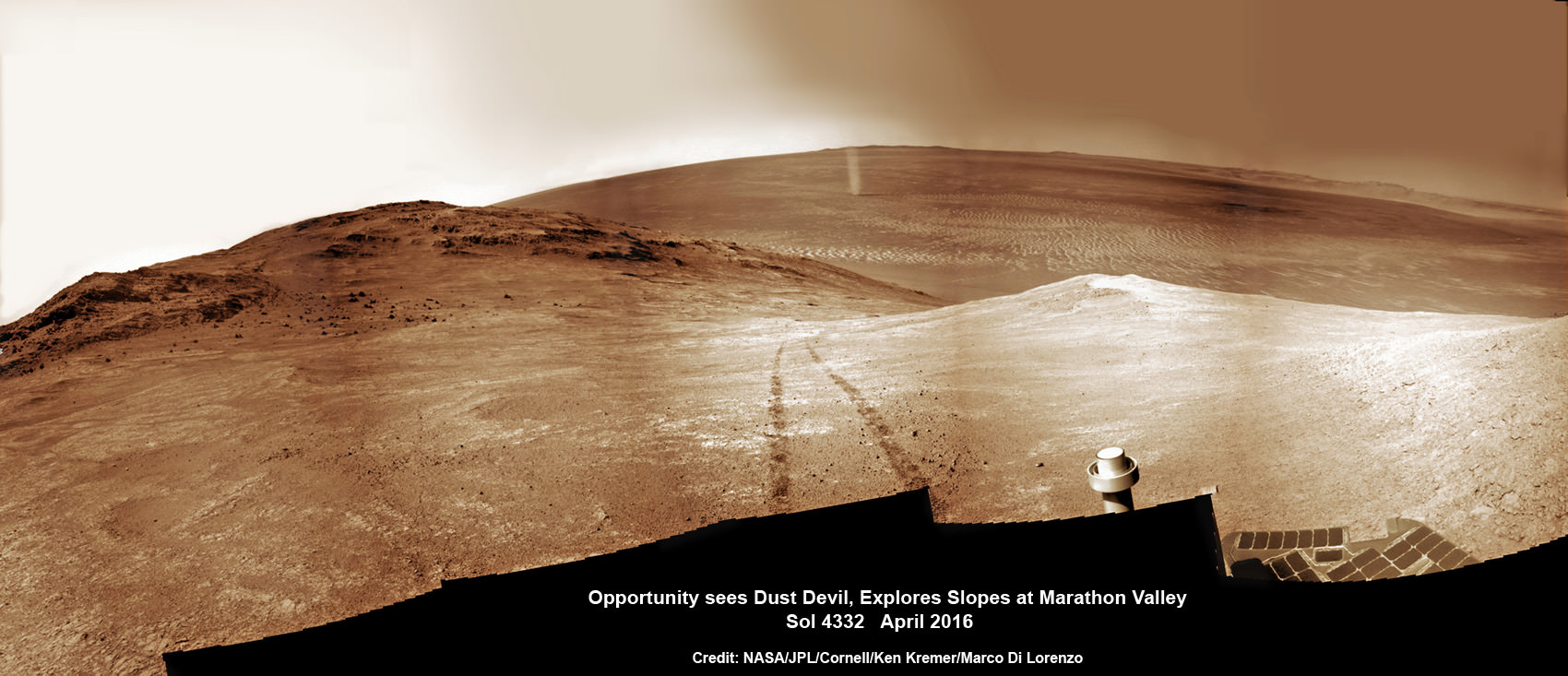
See our updated route map below. It shows the context of the rovers over 13 year long traverse spanning more than the 26 mile distance of a Marathon runners race.
The rover surpassed the 27 mile mark milestone on November 6, 2016 (Sol 4546).
The power output from solar array energy production is currently 416 watt-hours, before heading into another southern hemisphere Martian winter in 2017. It will count as Opportunities 8th winter on Mars.
Meanwhile Opportunity’s younger sister rover Curiosity traverses and drills into the lower sedimentary layers at the base of Mount Sharp.
Stay tuned here for Ken’s continuing Earth and planetary science and human spaceflight news.
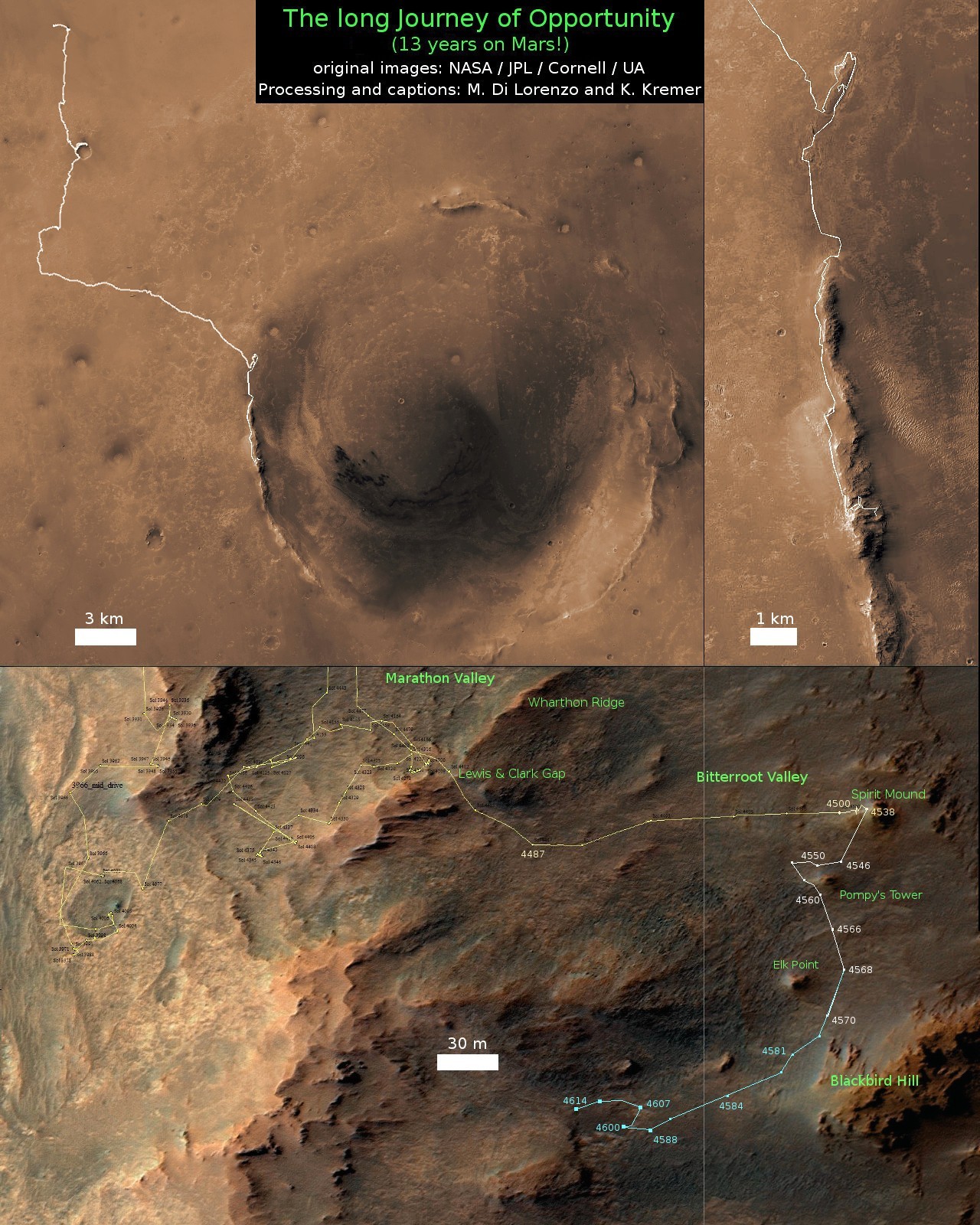
Is There Life on Mars?
Perhaps the most important question we can possible ask is, “are we alone in the Universe?”.
And so far, the answer has been, “I don’t know”. I mean, it’s a huge Universe, with hundreds of billions of stars in the Milky Way, and now we learn there are trillions of galaxies in the Universe.
Is there life closer to home? What about in the Solar System? There are a few existing places we could look for life close to home. Really any place in the Solar System where there’s liquid water. Wherever we find water on Earth, we find life, so it make sense to search for places with liquid water in the Solar System.
I know, I know, life could take all kinds of wonderful forms. Enlightened beings of pure energy, living among us right now. Or maybe space whales on Titan that swim through lakes of ammonia. Beep boop silicon robot lifeforms that calculate the wasted potential of our lives.
Sure, we could search for those things, and we will. Later. We haven’t even got this basic problem done yet. Earth water life? Check! Other water life? No idea.
It turns out, water’s everywhere in the Solar System. In comets and asteroids, on the icy moons of Jupiter and Saturn, especially Europa or Enceladus. Or you could look for life on Mars.

Mars is similar to Earth in many ways, however, it’s smaller, has less gravity, a thinner atmosphere. And unfortunately, it’s bone dry. There are vast polar caps of water ice, but they’re frozen solid. There appears to be briny liquid water underneath the surface, and it occasionally spurts out onto the surface. Because it’s close and relatively easy to explore, it’s been the place scientists have gone looking for past or current life.
Researchers tried to answer the question with NASA’s twin Viking Landers, which touched down in 1976. The landers were both equipped with three biology experiments. The researchers weren’t kidding around, they were going to nail this question: is there life on Mars?
In the first experiment, they took soil samples from Mars, mixed in a liquid solution with organic and inorganic compounds, and then measured what chemicals were released. In a second experiment, they put Earth organic compounds into Martian soil, and saw carbon dioxide released. In the third experiment, they heated Martian soil and saw organic material come out of the soil.

Three experiments, and stuff happened in all three. Stuff! Pretty exciting, right? Unfortunately, there were equally plausible non-biological explanations for each of the results. The astrobiology community wasn’t convinced, and they still fight in brutal cage matches to this day. It was ambitious, but inconclusive. The worst kind of conclusive.
Researchers found more inconclusive evidence in 1994. Ugh, there’s that word again. They were studying a meteorite that fell in Antarctica, but came from Mars, based on gas samples taken from inside the rock.
They thought they found evidence of fossilized bacterial life inside the meteorite. But again, there were too many explanations for how the life could have gotten in there from here on Earth. Life found a way… to burrow into a rock from Mars.
NASA learned a powerful lesson from this experience. If they were going to prove life on Mars, they had to go about it carefully and conclusively, building up evidence that had no controversy.

The Spirit and Opportunity Rovers were an example of building up this case cautiously. They were sent to Mars in 2004 to find evidence of water. Not water today, but water in the ancient past. Old water Over the course of several years of exploration, both rovers turned up multiple lines of evidence there was water on the surface of Mars in the ancient past.
They found concretions, tiny pebbles containing iron-rich hematite that forms on Earth in water. They found the mineral gypsum; again, something that’s deposited by water on Earth.
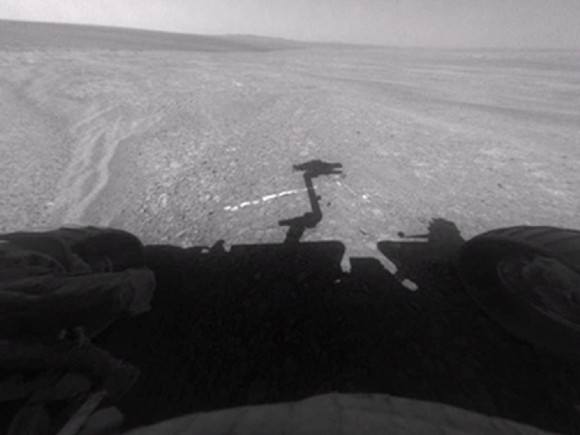
NASA’s Curiosity Rover took this analysis to the next level, arriving in 2012 and searching for evidence that water was on Mars for vast periods of time; long enough for Martian life to evolve.
Once again, Curiosity found multiple lines of evidence that water acted on the surface of Mars. It found an ancient streambed near its landing site, and drilled into rock that showed the region was habitable for long periods of time.
In 2014, NASA turned the focus of its rovers from looking for evidence of water to searching for past evidence of life.
Curiosity found one of the most interesting targets: a strange strange rock formations while it was passing through an ancient riverbed on Mars. While it was examining the Gillespie Lake outcrop in Yellowknife Bay, it photographed sedimentary rock that looks very similar to deposits we see here on Earth. They’re caused by the fossilized mats of bacteria colonies that lived billions of years ago.
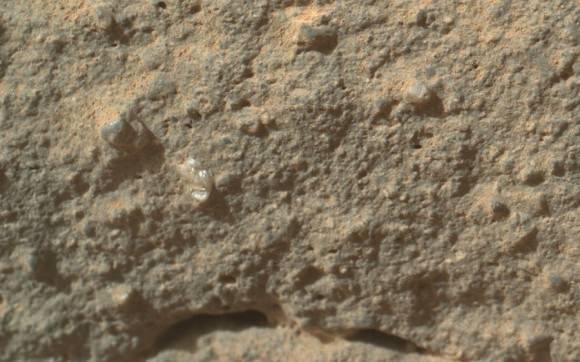
Not life today, but life when Mars was warmer and wetter. Still, fossilized life on Mars is better than no life at all. But there might still be life on Mars, right now, today. The best evidence is not on its surface, but in its atmosphere. Several spacecraft have detected trace amounts of methane in the Martian atmosphere.
Methane is a chemical that breaks down quickly in sunlight. If you farted on Mars, the methane from your farts would dissipate in a few hundred years. If spacecraft have detected this methane in the atmosphere, that means there’s some source replenishing those sneaky squeakers. It could be volcanic activity, but it might also be life. There could be microbes hanging on, in the last few places with liquid water, producing methane as a byproduct.
The European ExoMars orbiter just arrived at Mars, and its main job is sniff the Martian atmosphere and get to the bottom of this question.
Are there trace elements mixed in with the methane that means its volcanic in origin? Or did life create it? And if there’s life, where is it located? ExoMars should help us target a location for future study.
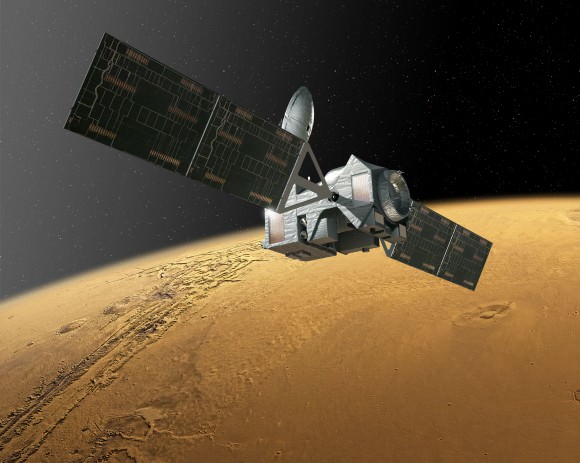
NASA is following up Curiosity with a twin rover designed to search for life. The Mars 2020 Rover will be a mobile astrobiology laboratory, capable of scooping up material from the surface of Mars and digesting it, scientifically speaking. It’ll search for the chemicals and structures produced by past life on Mars. It’ll also collect samples for a future sample return mission.
Even if we do discover if there’s life on Mars, it’s entirely possible that we and Martian life are actually related by a common ancestor, that split off billions of years ago. In fact, some astrobiologists think that Mars is a better place for life to have gotten started.
Not the dry husk of a Red Planet that we know today, but a much wetter, warmer version that we now know existed billions of years ago. When the surface of Mars was warm enough for liquid water to form oceans, lakes and rivers. And we now know it was like this for millions of years.

While Earth was still reeling from an early impact by the massive planet that crashed into it, forming the Moon, life on Mars could have gotten started early.
But how could we actually be related? The idea of Panspermia says that life could travel naturally from world to world in the Solar System, purely through the asteroid strikes that were regularly pounding everything in the early days.
Imagine an asteroid smashing into a world like Mars. In the lower gravity of Mars, debris from the impact could be launched into an escape trajectory, free to travel through the Solar System.
We know that bacteria can survive almost indefinitely, freeze dried, and protected from radiation within chunks of space rock. So it’s possible they could make the journey from Mars to Earth, crossing the orbit of our planet.
Even more amazingly, the meteorites that enter the Earth’s atmosphere would protect some of the bacterial inhabitants inside. As the Earth’s atmosphere is thick enough to slow down the descent of the space rocks, the tiny bacterialnauts could survive the entire journey from Mars, through space, to Earth.

If we do find life on Mars, how will we know it’s actually related to us? If Martian life has the similar DNA structure to Earth life, it’s probably related. In fact, we could probably trace the life back to determine the common ancestor, and even figure out when the tiny lifeforms make the journey.
If we do find life on Mars, which is related to us, that just means that life got around the Solar System. It doesn’t help us answer the bigger question about whether there’s life in the larger Universe. In fact, until we actually get a probe out to nearby stars, or receive signals from them, we might never know.
An even more amazing possibility is that it’s not related. That life on Mars arose completely independently. One clue that scientists will be looking for is the way the Martian life’s instructions are encoded. Here on Earth, all life follows “left-handed chirality” for the amino acid building blocks that make up DNA and RNA. But if right-handed amino acids are being used by Martian life, that would mean a completely independent origin of life.
Of course, if the life doesn’t use amino acids or DNA at all, then all bets are off. It’ll be truly alien, using a chemistry that we don’t understand at all.
There are many who believe that Mars isn’t the best place in the Solar System to search for life, that there are other places, like Europa or Enceladus, where there’s a vast amount of liquid water to be explored.
But Mars is close, it’s got a surface you can land on. We know there’s liquid water beneath the surface, and there was water there for a long time in the past. We’ve got the rovers, orbiters and landers on the planet and in the works to get to the bottom of this question. It’s an exciting time to be part of this search.
What is the Mars Curse?
Last week, ESA’s Schiaparelli lander smashed onto the surface of Mars. Apparently its descent thrusters shut off early, and instead of gently landing on the surface, it hit hard, going 300 km/h, creating a 15-meter crater on the surface of Mars.
Fortunately, the orbiter part of ExoMars mission made it safely to Mars, and will now start gathering data about the presence of methane in the Martian atmosphere. If everything goes well, this might give us compelling evidence there’s active life on Mars, right now.
It’s a shame that the lander portion of the mission crashed on the surface of Mars, but it’s certainly not surprising. In fact, so many spacecraft have gone to the galactic graveyard trying to reach Mars that normally rational scientists turn downright superstitious about the place. They call it the Mars Curse, or the Great Galactic Ghoul.
Mars eats spacecraft for breakfast. It’s not picky. It’ll eat orbiters, landers, even gentle and harmless flybys. Sometimes it kills them before they’ve even left Earth orbit.
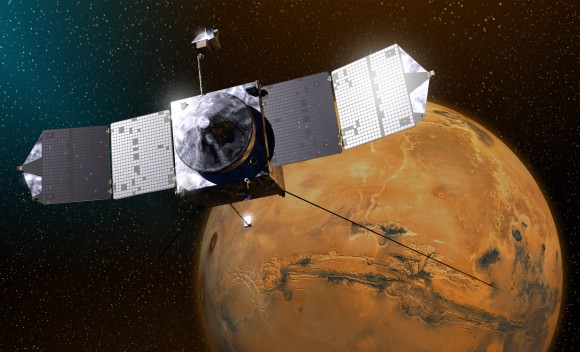
At the time I’m writing this article in late October, 2016, Earthlings have sent a total of 55 robotic missions to Mars. Did you realize we’ve tried to hurl that much computing metal towards the Red Planet? 11 flybys, 23 orbiters, 15 landers and 6 rovers.
How’s our average? Terrible. Of all these spacecraft, only 53% have arrived safe and sound at Mars, to carry out their scientific mission. Half of all missions have failed.
Let me give you a bunch of examples.
In the early 1960s, the Soviets tried to capture the space exploration high ground to send missions to Mars. They started with the Mars 1M probes. They tried launching two of them in 1960, but neither even made it to space. Another in 1962 was destroyed too.
They got close with Mars 1 in 1962, but it failed before it reached the planet, and Mars 2MV didn’t even leave the Earth’s orbit.
Five failures, one after the other, that must have been heartbreaking. Then the Americans took a crack at it with Mariner 3, but it didn’t get into the right trajectory to reach Mars.
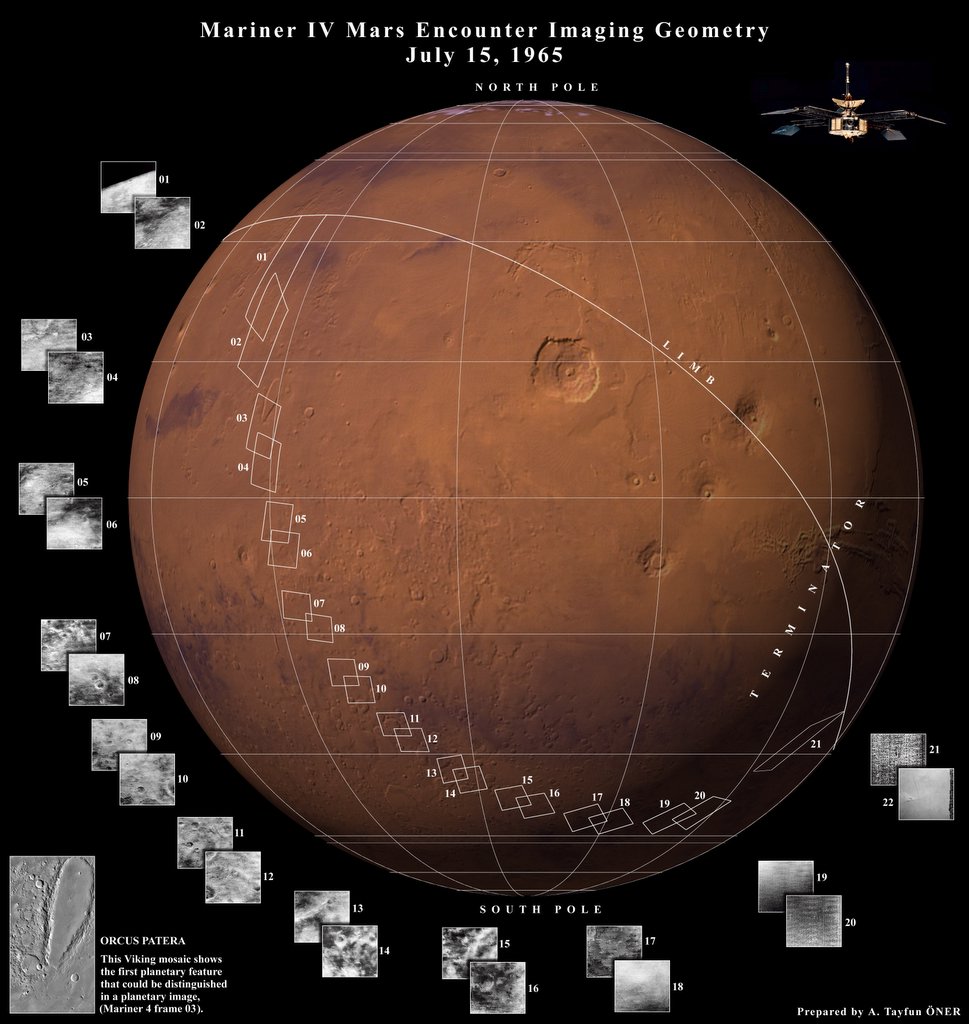
Finally, in 1964 the first attempt to reach Mars was successful with Mariner 4. We got a handful of blurry images from a brief flyby.
For the next decade, both the Soviets and Americans threw all kinds of hapless robots on a collision course with Mars, both orbiters and landers. There were a few successes, like Mariner 6 and 7, and Mariner 9 which went into orbit for the first time in 1971. But mostly, it was failure. The Soviets suffered 10 missions that either partially or fully failed. There were a couple of orbiters that made it safely to the Red Planet, but their lander payloads were destroyed. That sounds familiar.
Now, don’t feel too bad about the Soviets. While they were struggling to get to Mars, they were having wild success with their Venera program, orbiting and eventually landing on the surface of Venus. They even sent a few pictures back.
Finally, the Americans saw their greatest success in Mars exploration: the Viking Missions. Viking 1 and Viking 2 both consisted of an orbiter/lander combination, and both spacecraft were a complete success.
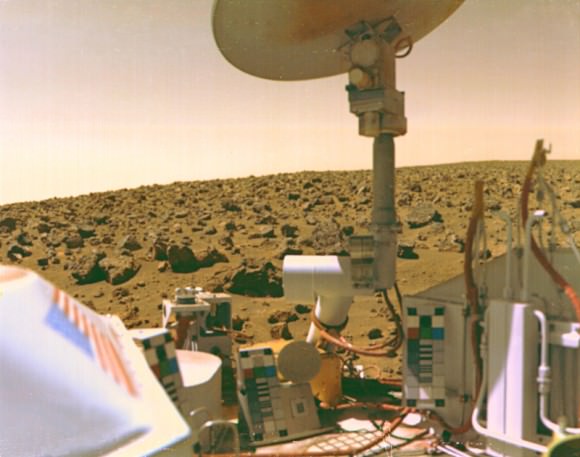
Was the Mars Curse over? Not even a little bit. During the 1990s, the Russians lost a mission, the Japanese lost a mission, and the Americans lost 3, including the Mars Observer, Mars Climate Orbiter and the Mars Polar Lander.
There were some great successes, though, like the Mars Global Surveyor and the Mars Pathfinder. You know, the one with the Sojourner Rover that’s going to save Mark Watney?
The 2000s have been good. Every single American mission has been successful, including Spirit and Opportunity, Curiosity, the Mars Reconnaissance Orbiter, and others.
But the Mars Curse just won’t leave the Europeans alone. It consumed the Russian Fobos-Grunt mission, the Beagle 2 Lander, and now, poor Schiaparelli. Of the 20 missions to Mars sent by European countries, only 4 have had partial successes, with their orbiters surviving, while their landers or rovers were smashed.
Is there something to this curse? Is there a Galactic Ghoul at Mars waiting to consume any spacecraft that dare to venture in its direction?
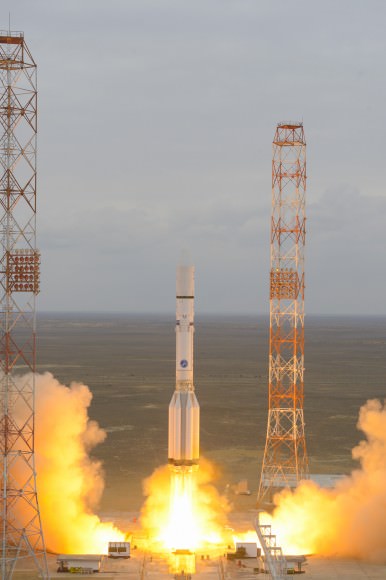
Flying to Mars is tricky business, and it starts with just getting off Earth. The escape velocity you need to get into low-Earth orbit is about 7.8 km/s. But if you want to go straight to Mars, you need to be going 11.3 km/s. Which means you might want a bigger rocket, more fuel, going faster, with more stages. It’s a more complicated and dangerous affair.
Your spacecraft needs to spend many months in interplanetary space, exposed to the solar winds and cosmic radiation.
Arriving at Mars is harder too. The atmosphere is very thin for aerobraking. If you’re looking to go into orbit, you need to get the trajectory exactly right or crash onto the planet or skip off and out into deep space.
And if you’re actually trying to land on Mars, it’s incredibly difficult. The atmosphere isn’t thin enough to use heatshields and parachutes like you can on Earth. And it’s too thick to let you just land with retro-rockets like they did on the Moon.
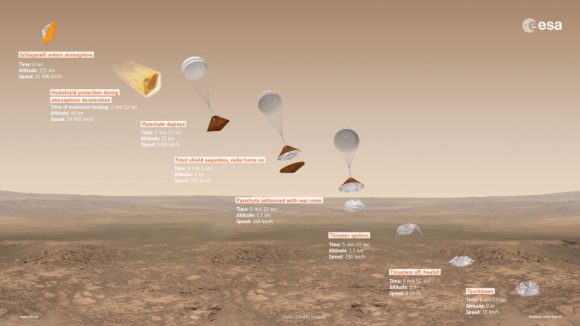
Landers need a combination of retro-rockets, parachutes, aerobraking and even airbags to make the landing. If any one of these systems fails, the spacecraft is destroyed, just like Schiaparelli.
If I was in charge of planning a human mission to Mars, I would never forget that half of all spacecraft ever sent to the Red Planet failed. The Galactic Ghoul has never tasted human flesh before. Let’s put off that first meal for as long as we can.
Opportunity Blazes Through 4500 Sunsets on Mars and Gullies are Yet to Come!


The longest living Martian rover ever – Opportunity – has just surpassed another unfathomable milestone – 4500 Sols (or days) exploring the Red Planet !! That’s 50 times beyond her “warrantied” life expectancy of merely 90 Sols.
And as we are fond of reporting – the best is yet to come. After experiencing 4500 Martian sunsets, Opportunity has been granted another mission extension and she is being targeted to drive to an ancient gully where life giving liquid water almost certainly once flowed on our solar systems most Earth-like planet.
See Opportunity’s current location around ‘Spirit Mound” – illustrated in our new photo mosaic panoramas above and below.
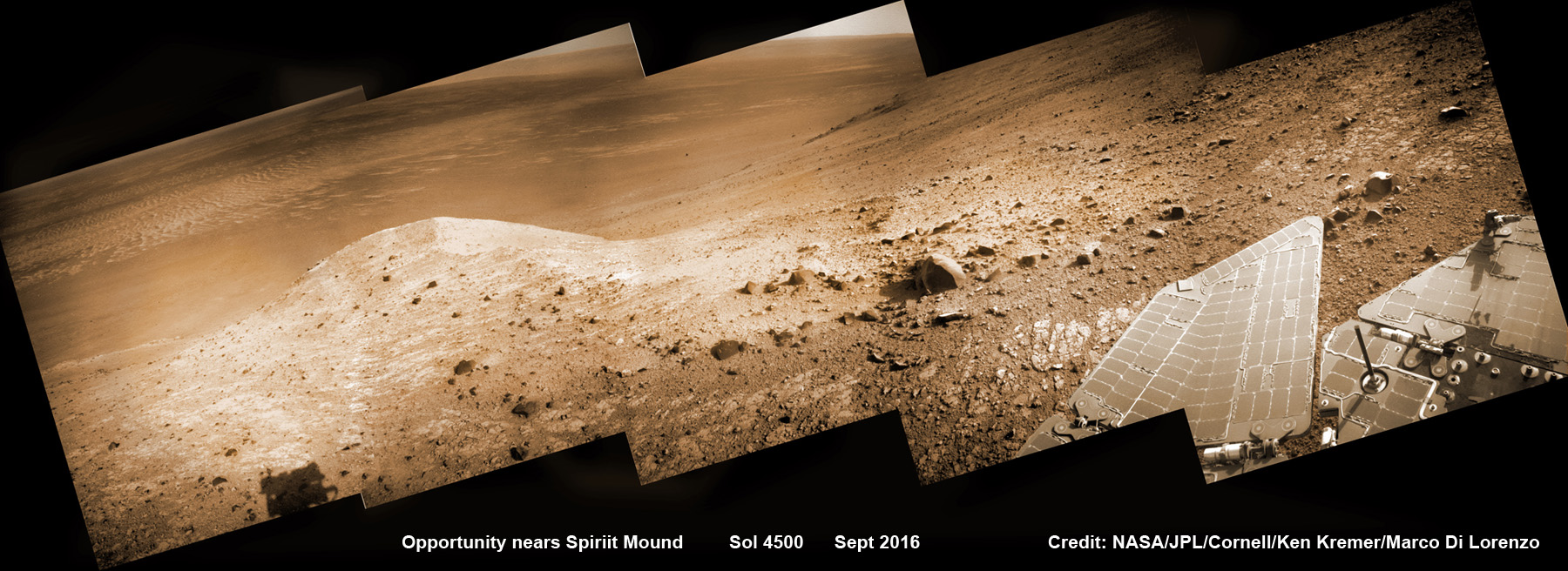
After a scorching ‘6 minutes of Terror’ plummet through the thin Martian atmosphere, Opportunity bounced to an airbag cushioned landing on the plains of Meridiani Planum on January 24, 2004 – nearly 13 years ago!
Opportunity was launched on a Delta II rocket from Cape Canaveral Air Force Station in Florida on July 7, 2003.
“We have now exceeded the prime-mission duration by a factor of 50,” noted Opportunity Project Manager John Callas of NASA’s Jet Propulsion Laboratory, Pasadena, California.
“Milestones like this are reminders of the historic achievements made possible by the dedicated people entrusted to build and operate this national asset for exploring Mars.”
The newest 2 year extended mission phase just began on Oct. 1 as the rover was stationed at the western rim of Endeavour crater at the bottom of Marathon Valley at a spot called “Bitterroot Valley.”
And at this moment, as Opportunity reached and surpassed the 4500 Sol milestone, she is investing an majestic spot dubbed “Spirit Mound” – and named after her twin sister “Spirit” – who landed 3 weeks earlier!

Endeavour crater spans some 22 kilometers (14 miles) in diameter. Opportunity has been exploring Endeavour since arriving at the humongous crater in 2011.
Endeavour crater was formed when it was carved out of the Red Planet by a huge meteor impact billions of years ago.
But now for the first time she will explore the craters interior, after spending 5 years investigating the exterior and climbing to a summit on the rim and spending several year exploring the top before finally descending down the Marathon Valley feature to investigate clay minerals formed in water.
“The longest-active rover on Mars also will, for the first time, visit the interior of the crater it has worked beside for the last five years,” said NASA officials.
Marathon Valley measures about 300 yards or meters long. It cuts downhill through the west rim of Endeavour crater from west to east – the same direction in which Opportunity drove downhill from a mountain summit area atop the crater rim. See our route map below showing the context of the rovers over dozen year long traverse spanning more than the 26 mile distance of a Marathon runners race.
Opportunity is now being targeted to explore a gully carved out by water.
“We are confident this is a fluid-carved gully, and that water was involved,” said Opportunity Principal Investigator Steve Squyres of Cornell University, Ithaca, New York.
“Fluid-carved gullies on Mars have been seen from orbit since the 1970s, but none had been examined up close on the surface before. One of the three main objectives of our new mission extension is to investigate this gully. We hope to learn whether the fluid was a debris flow, with lots of rubble lubricated by water, or a flow with mostly water and less other material.”
Furthermore, in what’s a very exciting announcement the team “intends to drive Opportunity down the full length of the gully, onto the crater floor” – if the rover continues to function well during the two year extended mission which will have to include enduring her 8th frigid Martian winter in 2017.
And as is always the case, scientists will compare these interior crater rocks to those on the exterior for clues into the evolution, environmental and climatic history of Mars over billions of years.
“We may find that the sulfate-rich rocks we’ve seen outside the crater are not the same inside,” Squyres said. “We believe these sulfate-rich rocks formed from a water-related process, and water flows downhill. The watery environment deep inside the crater may have been different from outside on the plain — maybe different timing, maybe different chemistry.”

As of today, Sol 4522, Oct 12, 2016, Opportunity has taken over 214,400 images and traversed over 26.99 miles (43.44 kilometers) – more than a marathon.
The power output from solar array energy production is currently 472 watt-hours, before heading into another southern hemisphere Martian winter in 2017.
Meanwhile Opportunity’s younger sister rover Curiosity traverses and drills into the basal layers at the base of Mount Sharp.
Stay tuned here for Ken’s continuing Earth and planetary science and human spaceflight news.
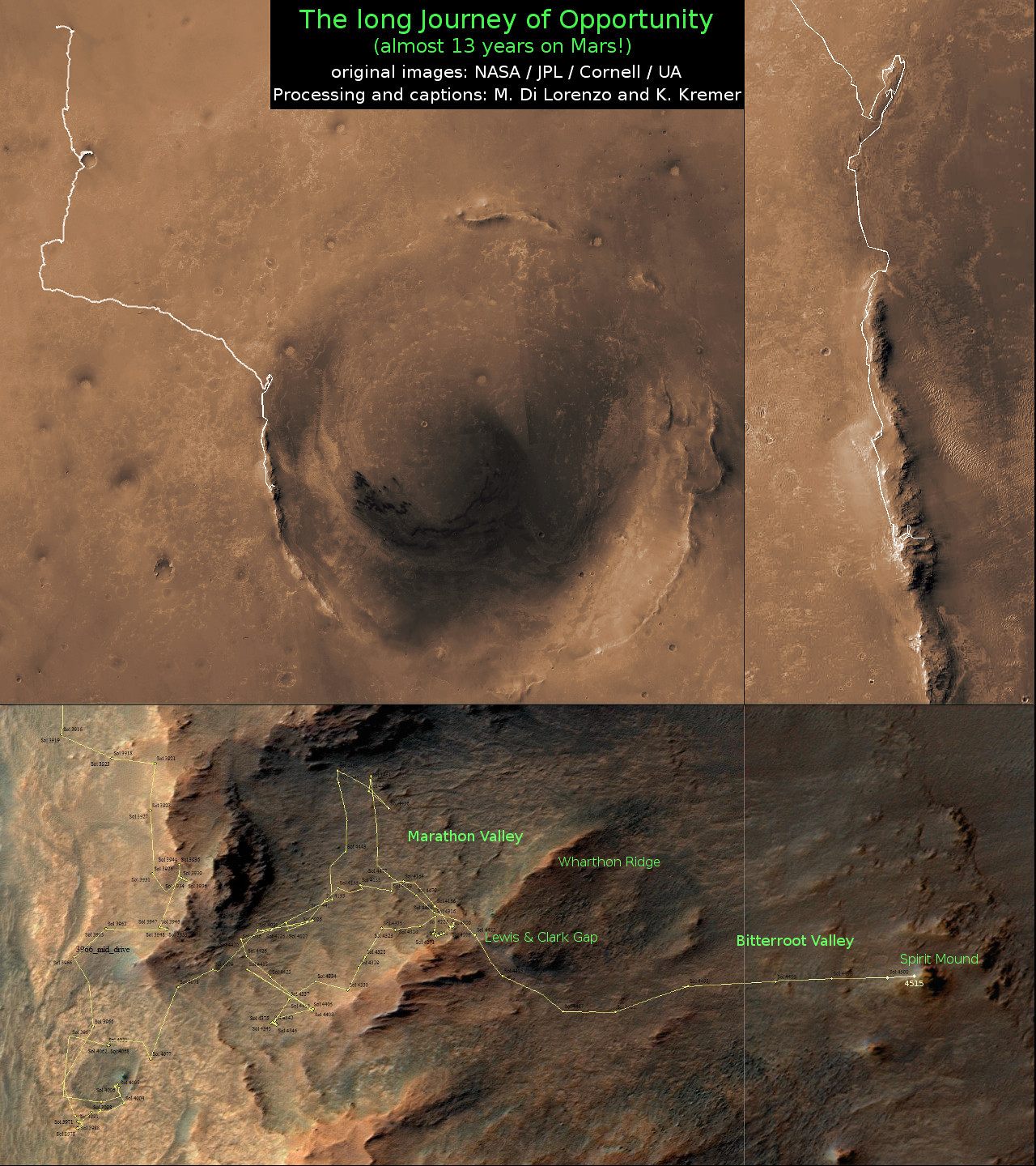
What Does Earth Look like from Mars?

Modern astronomy and space exploration has blessed us with a plethora of wonderful images. Whether they were images of distant planets, stars and galaxies taken by Earth-based telescopes, or close-ups of planets or moons in our own Solar System by spacecraft, there has been no shortage of inspiring pictures. But what would it look like to behold planet Earth from another celestial body?
We all remember the breathtaking photos taken by the Apollo astronauts that showed what Earth looked like from the Moon. But what about our next exploration destination, Mars? With all the robotic missions on or in orbit around the Red Planet, you’d think that there would have been a few occasions where they got a good look back at Earth. Well, as it turn out, they did!
Pictures from Space:
Pictures of Earth have been taken by both orbital missions and surface missions to Mars. The earliest orbiters, which were part of the Soviet Mars and NASA Mariner programs, began arriving in orbit around Mars by 1971. NASA’s Mariner 9 probe was the first to establish orbit around the planet’s (on Nov. 14, 1971), and was also the first spacecraft to orbit another planet.

The first orbiter to capture a picture of Earth from Mars, however, was the Mars Global Surveyor, which launched in Nov. 7th, 1996, and arrived in orbit around the planet on Sept. 12th, 1997. In the picture (shown above), which was taken in 2003, we see Earth and the Moon appearing closely together.
At the time the picture was taken, the distance between Mars and Earth was 139.19 million km (86.49 million mi; 0.9304 AU) while the distance between Mars and the Moon was 139.58 million km (86.73 million mi; 0.9330 AU). Interestingly enough, this is what an observer would see from the surface of Mars using a telescope, whereas a naked-eye observer would simply see a single point of light.
Usually, the Earth and Moon are visible as two separate points of light, but at this point in the Moon’s orbit they were too close to resolve with the naked eye from Mars. If you look closely at Earth, you can just make out the shape of South America.

The picture above was snapped by the Mars Express’s High Resolution Stereo Camera (HRSC) on the ESA’s Mars Express probe. It was also taken in 2003, and is similar in that it shows the Earth and Moon together. However, in this image, we see the two bodies at different points in their orbit – which is why the Moon looks like its farther away. Interestingly enough, this image was actually part of the first data sets to be sent by the spacecraft.
The next orbiter to capture an image of Earth from Mars was the Mars Reconnaissance Orbiter (MRO), which was launched in August of 2005 and attained Martian orbit on March 10th, 2006. When the probe reached Mars, it joined five other active spacecraft that were either in orbit or on the surface, which set a record for the most operational spacecraft in the vicinity of Mars at the same time.
In the course of its mission – which was to study Mars’ surface and weather conditions, as well as scout potential landing sites – the orbiter took many interesting pictures. The one below was taken on Oct. 3rd, 2007, which showed the Earth and the Moon in the same frame.

Pictures from the Surface:
As noted already, pictures of Earth have also been taken by robotic missions to the surface of Mars. This has been the case for as long as space agencies have been sending rovers or landers that came equipped with mobile cameras. The earliest rovers to reach the surface – Mars 2 and Mars 3– were both sent by the Soviets.
However, it was not until early March of 2004, while taking photographs of the Martian sky, that the Spirit rover became the first to snap a picture of Earth from the surface of another planet. This image was caught while the rover was attempting to observe Mars’ moon Deimos making a transit of the Sun (i.e. a partial eclipse).
This is something which happens quite often given the moon’s orbital period of about 30 hours. However, on this occasion, the rover managed to also capture a picture of distant Earth, which appeared as little more than a particularly bright star in the night sky.

The next rover to snap an image of Earth from the Martian surface was Curiosity, which began sending back many breathtaking photos even before it landed on Aug. 6th, 2012. And on Jan. 31st, 2014 – almost a year and a half into its mission – the rover managed to capture an image of both Earth and the Moon in the night sky.
In the image (seen below), Earth and the Moon are just visible as tiny dots to the naked eye – hence the inset that shows them blown up for greater clarity. The distance between Earth and Mars when Curiosity took the photo was about 160 million km (99 million mi).
Earth has been photographed from Mars several times now over the course of the past few decades. Each picture has been a reminder of just how far we’ve come as a species. It also provides us with a preview of what future generations may see when looking out their cabin window, or up at the night sky from other planets.

We have written many interesting articles about Earth and Mars here at Universe Today. Here’s Incredible Image of Mars from Earth, Mars Compared to Earth, How Far is Mars from Earth, and How Long Does it Take to get to Mars?
For more information, be sure to check out NASA’s Solar System Exploration page on Mars.
Astronomy Cast also has an interesting episode on the subject – Episode 52: Mars
Sources:
Peculiar ‘Cauliflower Rocks’ May Hold Clues To Ancient Mars Life
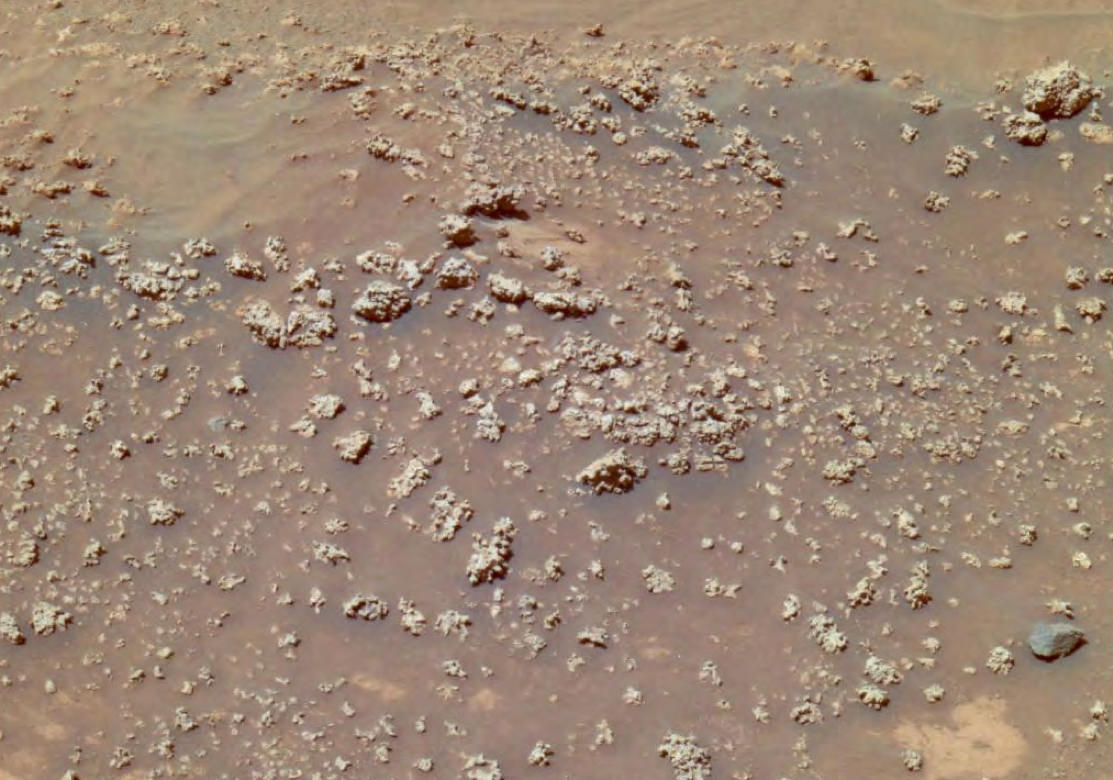

Evidence of water and a warmer, wetter climate abound on Mars, but did life ever put its stamp on the Red Planet? Rocks may hold the secret. Knobby protuberances of rock discovered by the Spirit Rover in 2008 near the rock outcrop Home Plate in Gusev Crater caught the attention of scientists back on Earth. They look like cauliflower or coral, but were these strange Martian rocks sculpted by microbes, wind or some other process?
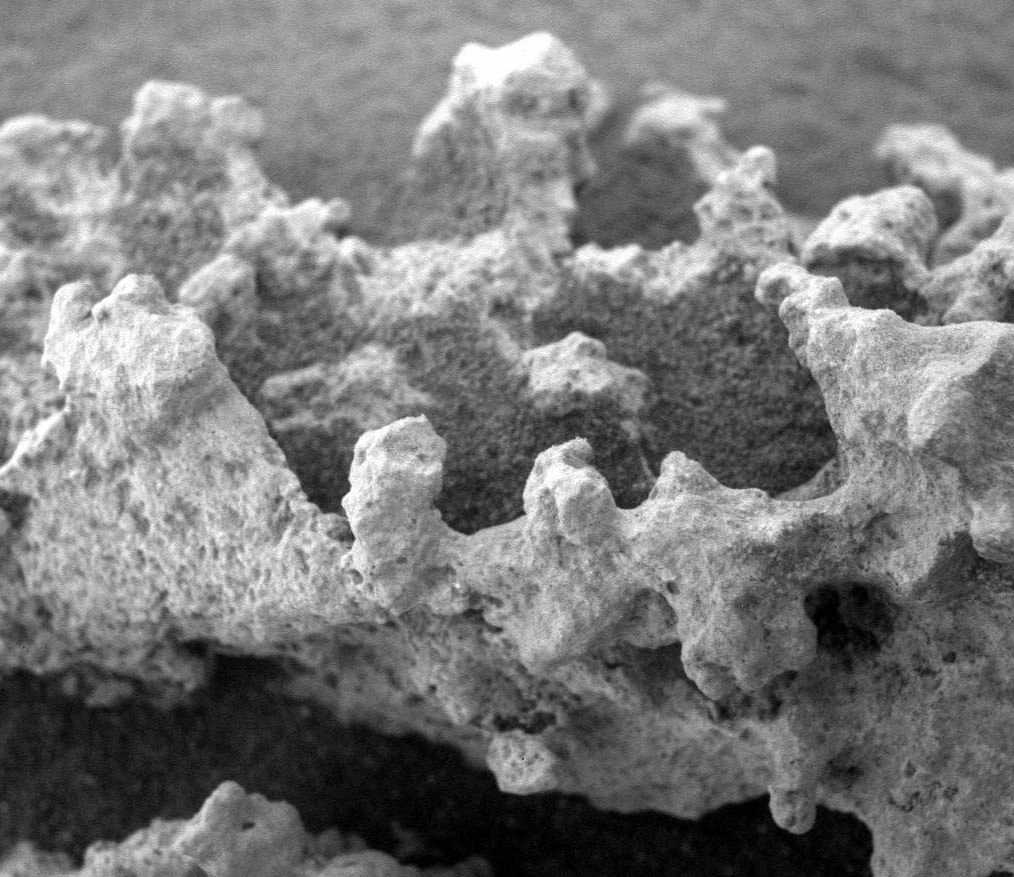
When analyzed by Spirit’s mini-TES (Mini-
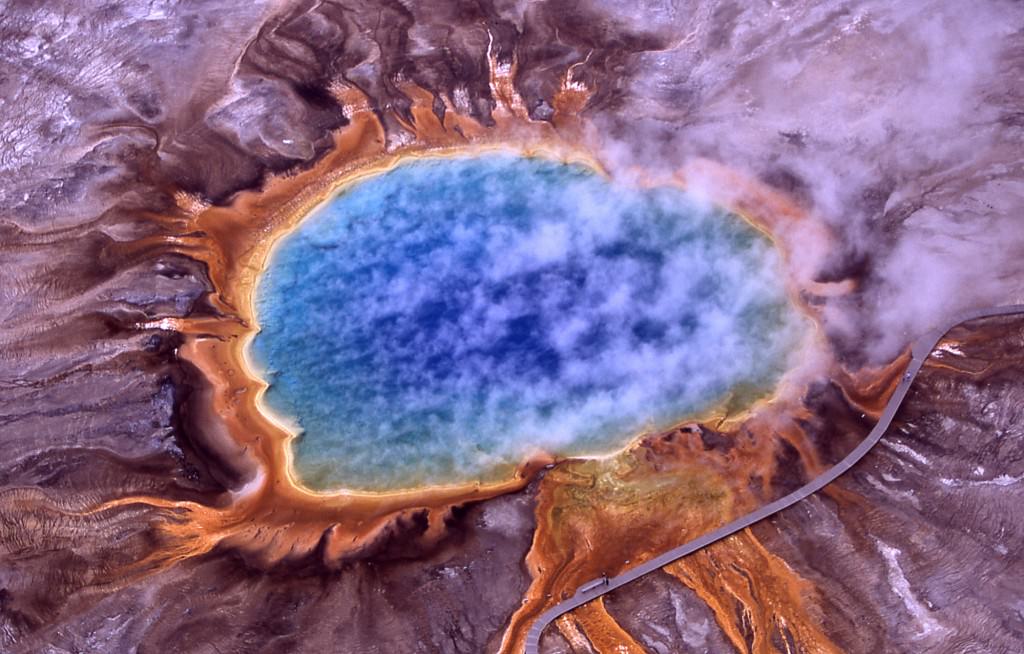
Both at Yellowstone, the Taupo Volcanic Zone in New Zealand and in Iceland, heat-loving bacteria are intimately involved in creating curious bulbous and branching shapes in silica formations that strongly resemble the Martian cauliflower rocks. New research presented at the American Geophysical Union meeting last month by planetary geologist Steven Ruff and geology professor Jack Farmer, both of Arizona State University, explores the possibility that microbes might have been involved in fashioning the Martian rocks, too.
A sizzling visit to El Tatio’s geysers
The researchers ventured to the remote geyser fields of El Tatio in the Chilean Atacama Desert to study an environment that may have mimicked Gusev Crater billions of years ago when it bubbled with hydrothermal activity. One of the driest places on Earth, the Atacama’s average elevation is 13,000 feet (4 km), exposing it to considerably more UV light from the sun and extreme temperatures ranging from -13°F to 113°F (-10° to 45°C). Outside of parts of Antarctica, it’s about as close to Mars as you’ll find on Earth.
Ruff and Farmer studied silica deposits around hot springs and geysers in El Tatio and discovered forms they call “micro-digitate silica structures” similar in appearance and composition to those on Mars (Here’s a photo). The infrared spectra of the two were also a good match. They’re still analyzing the samples to determine if heat-loving microbes may have played a role in their formation, but hypothesize that the features are “micro-stromatolites” much like those found at Yellowstone and Taupo.
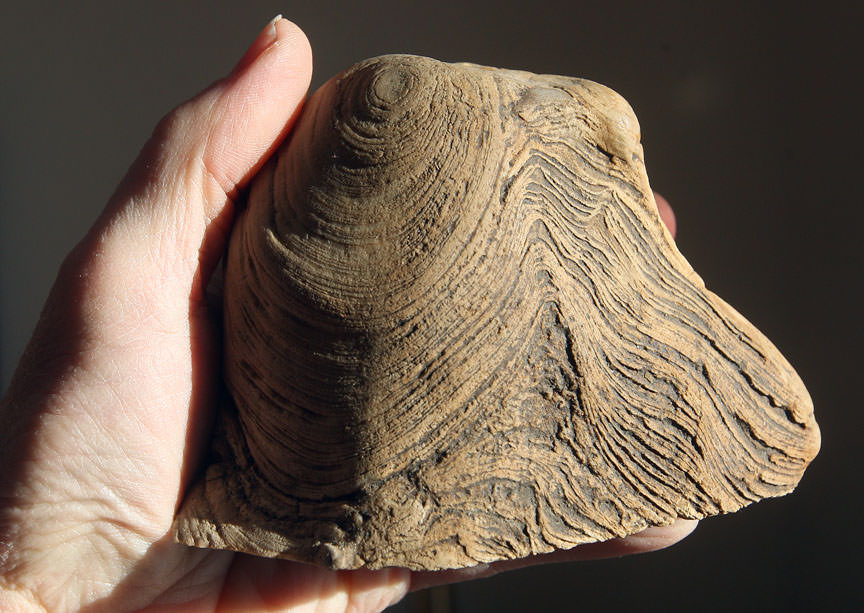
Stromatolites form when a sticky film of bacteria traps and cements mineral grains to create a thin layer. Other layers form atop that one until a laminar mound or column results. The most ancient stromatolites on Earth may be about 3.5 billion years old. If Ruff finds evidence of biology in the El Tatio formations in the punishing Atacama Desert environment, it puts us one step closer to considering the possibility that ancient bacteria may have been at work on Mars.
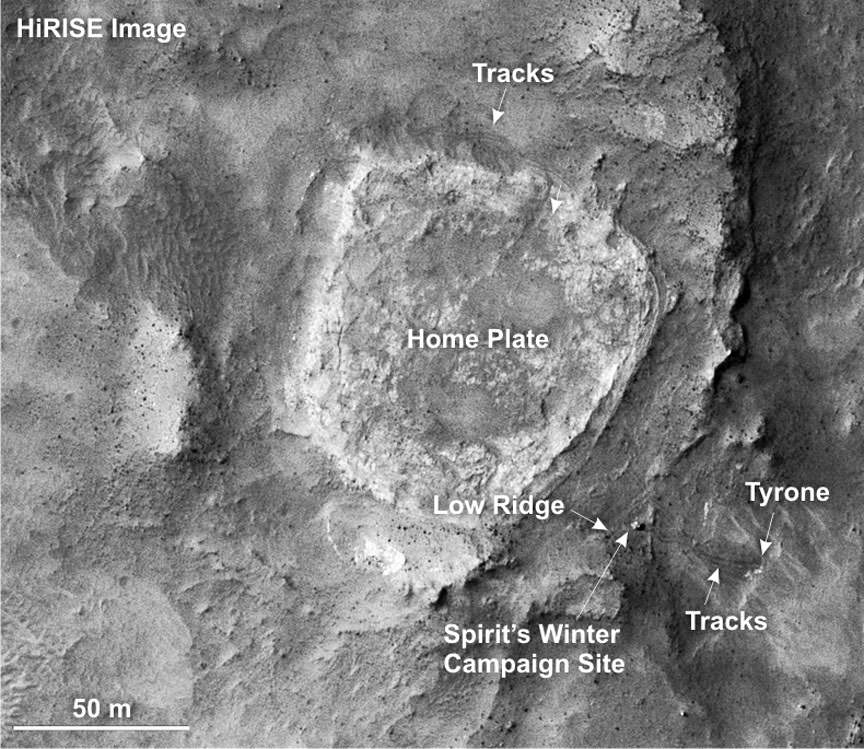
Silica forms may originate with biology or from non-biological processes like wind, water and other environmental factors. Short of going there and collecting samples, there’s no way to be certain if the cauliflower rocks are imprinted with the signature of past Martian life. But at least we know of a promising place to look during a future sample return mission to the Red Planet. Indeed, according to Ruff, the Columbia Hills inside Gusev Crater he short list of potential sites for the 2020 Mars rover.
More resources:
- Steve Ruff paper comparing El Tatio with an early hot springs environment in Gusev Crater
- Spirit Rover raw image archive
- Details about the Spirit’s discovery of silica


